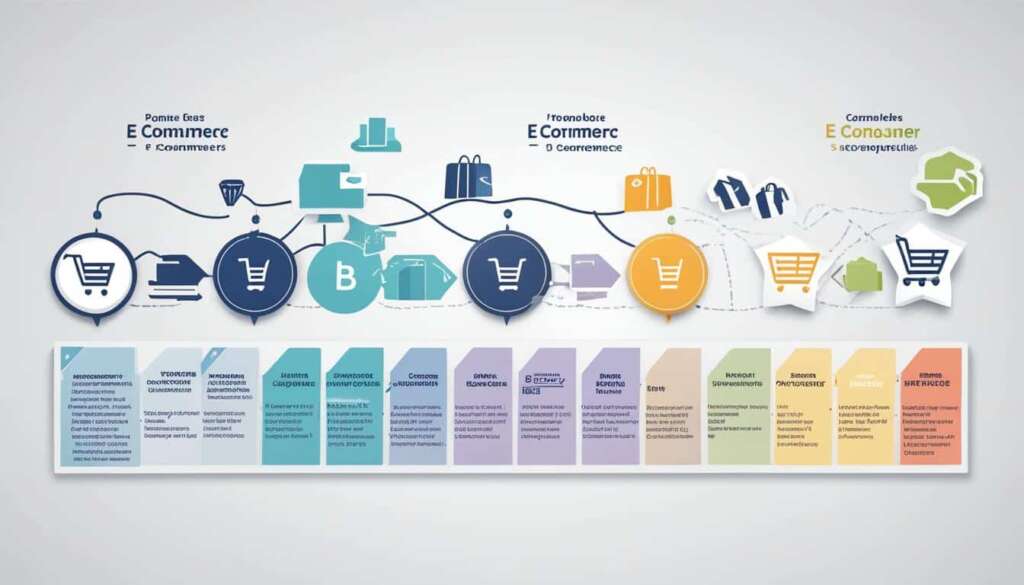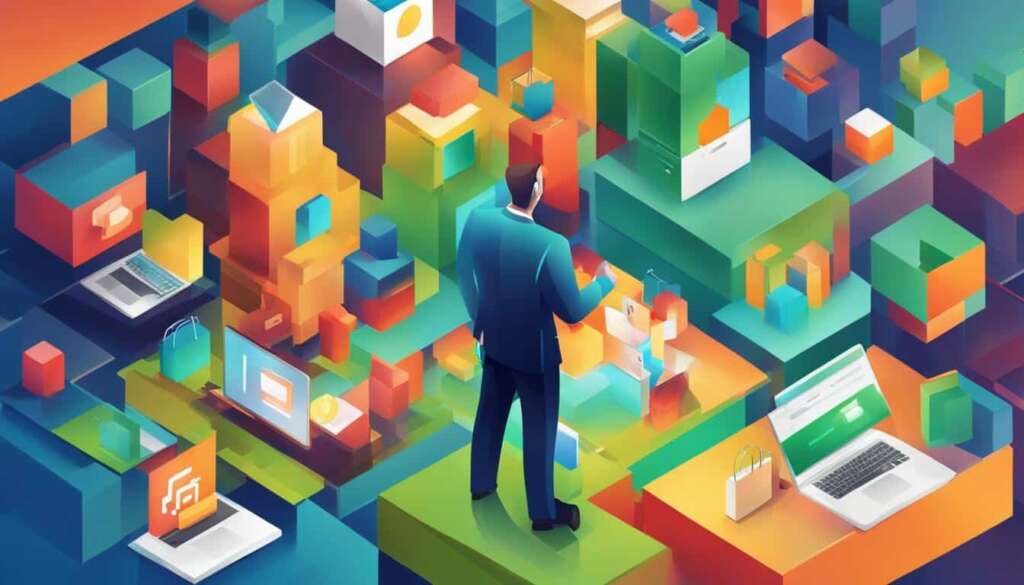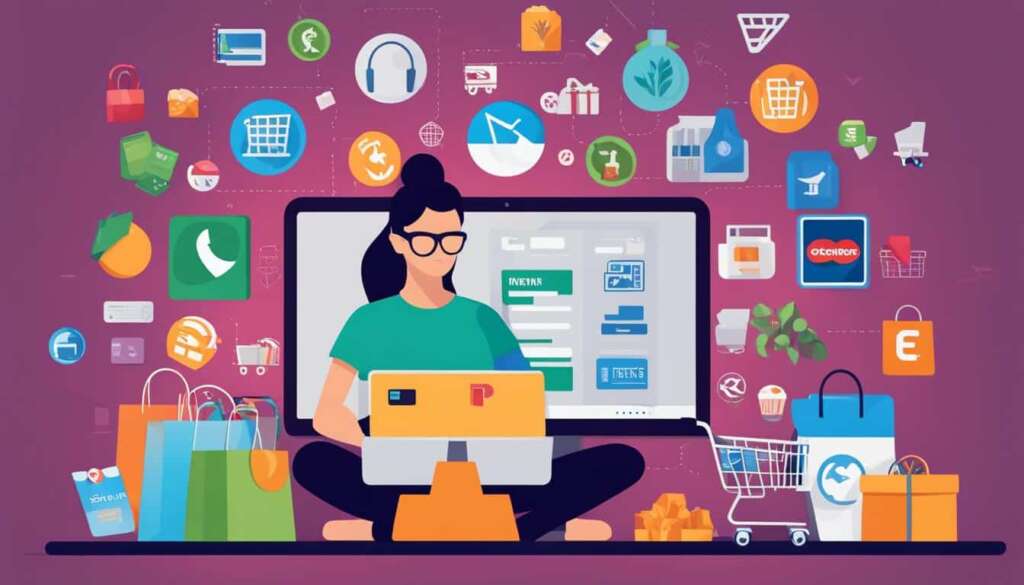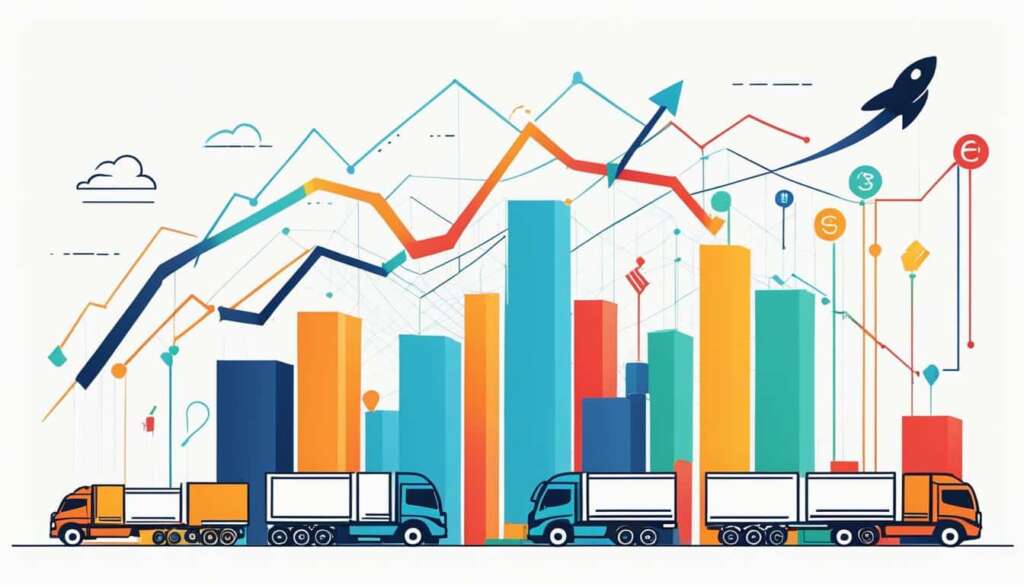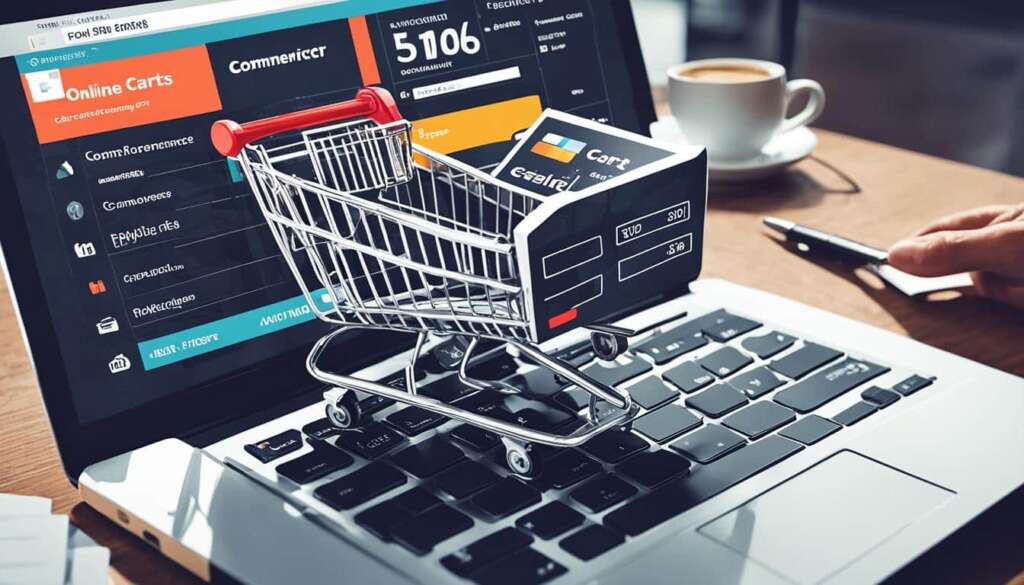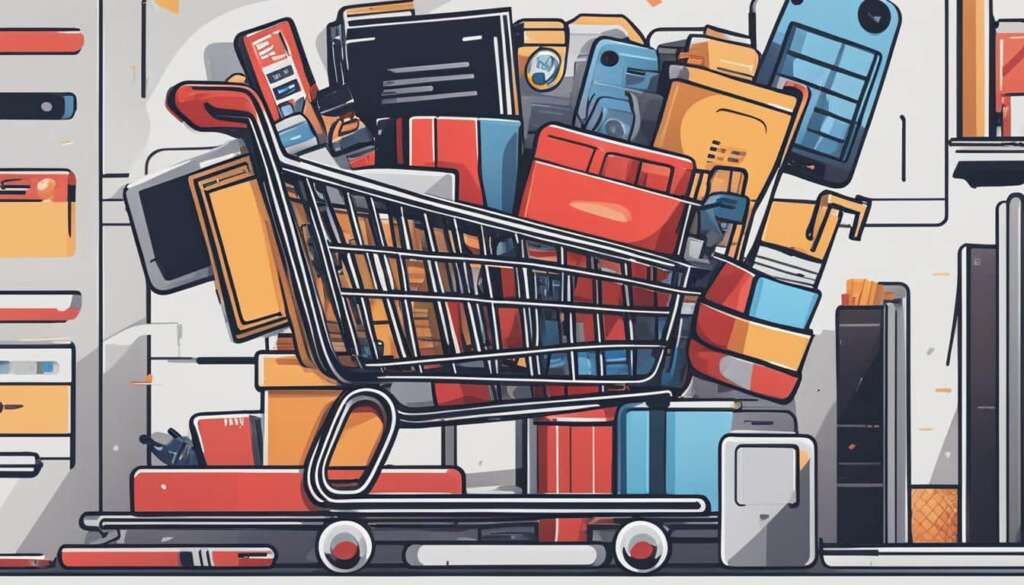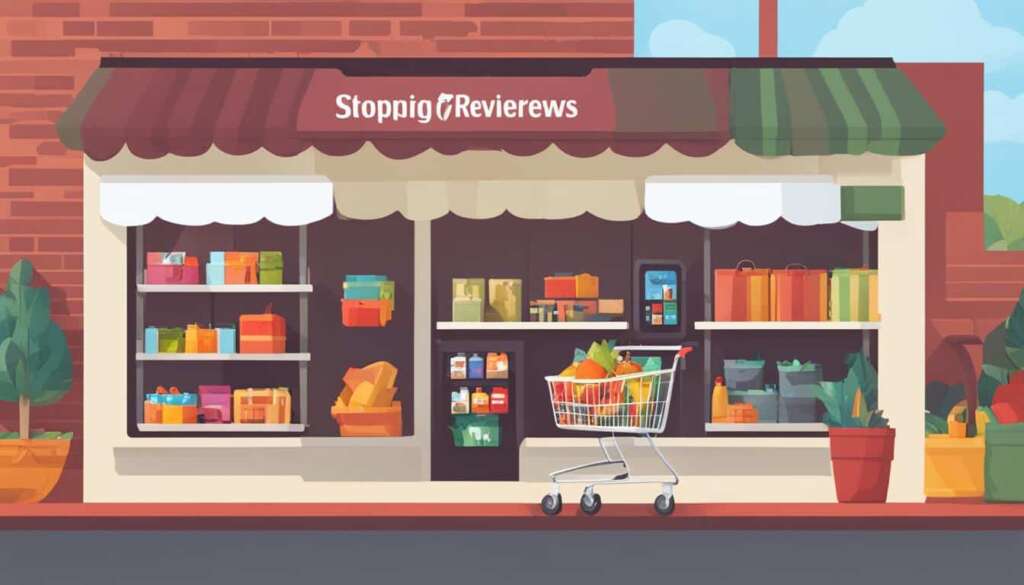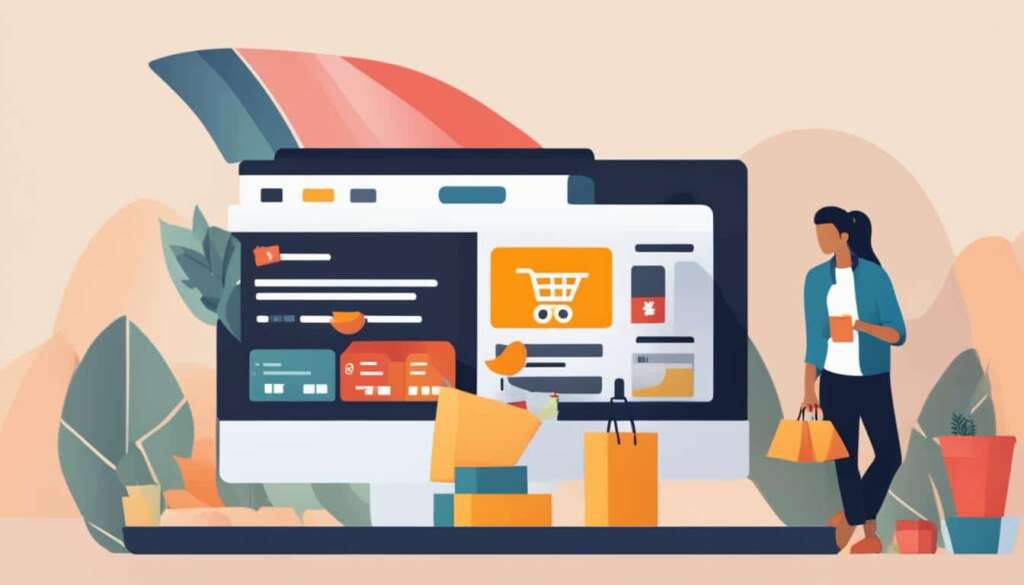Table of Contents
E-commerce has revolutionized the way businesses operate, providing a convenient and efficient platform for buying and selling products and services online. To navigate this ever-growing industry, it is essential to understand the different types of e-commerce models available.
E-commerce models refer to the various approaches businesses take to connect with their target audience and generate sales. By embracing the right model, businesses can optimize their online presence and drive growth. Let’s delve into the six major types of e-commerce models:
- B2C (business-to-consumer): This model involves businesses selling products or services directly to individual consumers. Online retail giants like Amazon and eBay are prime examples of B2C e-commerce platforms.
- B2B (business-to-business): In this model, businesses sell products or services to other businesses. It includes wholesale transactions and often involves procurement processes.
- B2B2C (business-to-business-to-consumer): This model revolves around partnerships, where businesses collaborate to sell products or services to end consumers. It offers a unique revenue-sharing opportunity.
- B2G (business-to-government): Businesses in this model focus on selling products or services to government entities and public administrations. This often involves participating in government bidding processes.
- C2B (consumer-to-business): In the C2B model, consumers sell goods or services directly to businesses. This can occur through platforms that allow consumers to bid for business-related opportunities.
- C2C (consumer-to-consumer): C2C e-commerce occurs when consumers buy and sell products or services directly to each other through online marketplaces. Platforms like eBay and Facebook Marketplace facilitate C2C transactions.
Each e-commerce model has its unique characteristics, target audience, and advantages. By understanding the options available, businesses can make informed decisions and choose the most suitable model to achieve their online business goals.
B2C (Business-to-Consumer) E-commerce Model
In the world of e-commerce, the B2C (Business-to-Consumer) model is a popular and thriving approach. This model revolves around businesses selling their products or services directly to end consumers, bypassing any intermediaries. B2C e-commerce involves online retail stores that offer a wide range of products, from clothing and electronics to home decor and beauty products.
Unlike B2B transactions that occur between businesses, B2C transactions have shorter sales cycles, lower average order values, and fewer recurring orders. The focus in this model is on creating seamless and user-friendly experiences for individual customers.
B2C e-commerce has gained immense momentum in recent years due to the growing popularity of online shopping and the convenience it offers. To succeed in this competitive landscape, businesses in the B2C model must leverage technology to effectively target and market directly to their customers. Strategies like mobile apps and remarketing have proven to be game-changers in reaching and engaging with the ever-evolving consumer base.
In a B2C e-commerce ecosystem, the primary goal is to attract and convert website visitors into paying customers. By understanding consumer behavior, preferences, and purchase patterns, businesses can tailor their marketing messages and offers to maximize conversions. This targeted approach allows for increased customer satisfaction and repeat business.
Here’s an image that provides a visual representation of the B2C e-commerce model:
Additionally, B2C businesses often invest in creating compelling brand experiences to differentiate themselves from the competition. This includes designing user-friendly websites, offering personalized recommendations, and providing excellent customer service throughout the entire purchase journey.
“The B2C e-commerce model is all about connecting businesses directly with their end consumers. It’s a dynamic and ever-evolving space that requires businesses to adapt and innovate to stay ahead.”
Despite the fierce competition in the B2C e-commerce space, this model presents significant opportunities for businesses to thrive and succeed. By understanding consumer trends, leveraging technology, and offering exceptional customer experiences, B2C e-commerce businesses can build strong relationships with their target audience and drive consistent growth in the online retail industry.
B2B (Business-to-Business) E-commerce Model
In the B2B e-commerce model, businesses engage in transactions with other businesses, catering to their specific needs. This can encompass vertical-oriented businesses operating within a particular industry or horizontal businesses that serve multiple industries. B2B e-commerce primarily focuses on large-scale operations, facilitating wholesale transactions and offering specialized products or services tailored to the business market.
B2B transactions typically involve longer sales cycles, higher order values, and more recurring purchases compared to B2C transactions. As businesses often require large quantities of products or services, B2B e-commerce enables them to conveniently source their requirements through online platforms. This streamlines the procurement process, allowing businesses to save time and resources.
The emergence of digital strategies in B2B e-commerce has transformed the landscape by providing innovative solutions. Through online platforms, businesses can showcase their products or services to a wider audience and directly engage with potential customers. The convenience and accessibility of these platforms have enabled businesses to enhance their sales and expand their reach.
The Advantages of B2B E-commerce
The B2B e-commerce model offers several advantages for businesses:
- Increased Efficiency: B2B e-commerce streamlines the ordering process, reducing manual intervention and paperwork. Businesses can browse through catalogs, access real-time inventory information, place orders, and even track shipments, simplifying the entire buying journey.
- Expanded Market Reach: Online B2B platforms provide access to a global network of businesses, eliminating geographical limitations. This allows businesses to tap into new markets, forge partnerships, and expand their customer base.
- Cost Savings: B2B e-commerce eliminates the need for physical storefronts and reduces overhead costs associated with traditional sales channels. Additionally, the efficient procurement process and bulk purchasing opportunities often result in cost savings for businesses.
- Data-Driven Decision Making: Online platforms provide businesses with valuable data insights, enabling them to optimize their offerings and make informed decisions. Analyzing customer preferences, purchase patterns, and market trends empowers businesses to tailor their strategies and enhance their competitive advantage.
Implementing a successful B2B e-commerce strategy requires businesses to focus on building strong relationships with their customers. Providing excellent customer service, offering personalized experiences, and maintaining transparent communication are crucial for nurturing long-term partnerships.
| Key Features of B2B E-commerce | Benefits |
|---|---|
| Integration with ERP Systems | Streamlined order processing, inventory management, and invoicing. |
| Custom Pricing and Negotiation | Flexibility in pricing and terms based on the specific needs of business customers. |
| Advanced Product Catalog | Easy navigation and comprehensive product information to facilitate informed purchasing decisions. |
| Order Tracking and Management | Real-time visibility into order status, shipment tracking, and delivery updates for improved customer satisfaction. |
| Recurring Orders and Subscription Models | Seamless reordering processes and subscription-based services for enhanced customer convenience. |
Adopting B2B e-commerce opens doors to new opportunities and enables businesses to leverage technology for growth. By embracing the digital landscape, businesses can thrive in an increasingly interconnected global market.
B2B2C (Business-to-Business-to-Consumer) E-commerce Model
The B2B2C e-commerce model is a strategic approach that allows businesses to leverage partnerships to reach end consumers, fostering growth and increasing revenue through collaborative efforts. Unlike white labeling, where a product is rebranded by another company, B2B2C maintains the original company’s branding, ensuring that the end customer recognizes and trusts the original brand. This model creates a win-win situation for all parties involved by expanding customer reach and driving sales through shared resources and expertise.
Partnerships: In the B2B2C model, businesses form strategic partnerships with other organizations to tap into new markets and customer segments. These partnerships can be with manufacturers, wholesalers, or even other retailers who share a similar target audience. By collaborating, businesses can benefit from each other’s strengths and complement their product offerings, resulting in a broader range of products or services for end consumers.
Revenue Sharing: One of the key aspects of the B2B2C model is revenue sharing. This allows businesses to distribute revenue based on the value each partner brings to the collaboration. Revenue sharing agreements can be structured in various ways, such as a percentage of sales or a fixed fee per transaction. This ensures that each partner is appropriately compensated for their contributions and incentivizes continued collaboration.
By adopting the B2B2C model, businesses can tap into new markets and customer segments, expand their product offerings, and drive revenue growth through strategic partnerships and revenue sharing. This collaborative approach not only benefits the businesses involved but also enhances the overall customer experience as they gain access to a wider range of products or services from trusted brands.
“The B2B2C model enables businesses to leverage partnerships and revenue sharing to reach more customers and drive growth.” – John Smith, E-commerce Expert
Advantages of the B2B2C E-commerce Model
The B2B2C e-commerce model offers several advantages for businesses:
- Expanded Customer Reach: By partnering with other organizations, businesses can access new customer segments and tap into markets that they may not have been able to reach independently.
- Increased Product Offering: Collaboration with other businesses allows for a wider range of products or services to be offered to end consumers, enhancing the overall customer experience.
- Shared Resources and Expertise: Partnerships provide access to shared resources, such as distribution networks, marketing channels, and industry expertise, which can significantly benefit both parties.
- Brand Recognition and Trust: Maintaining the original brand identity in the B2B2C model helps establish trust and credibility with the end consumer, leading to increased brand loyalty and repeat purchases.
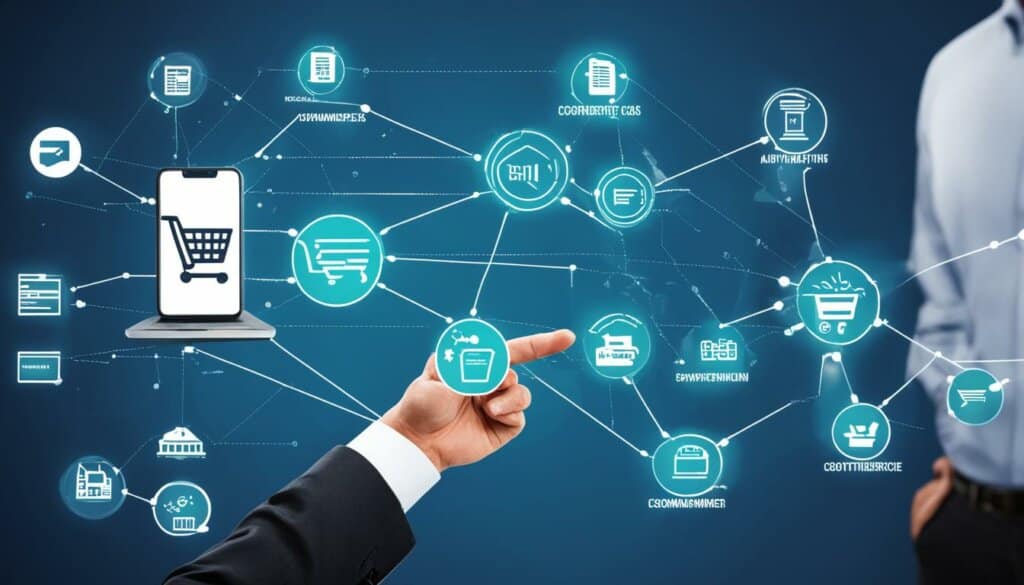
| Advantages of B2B2C E-commerce Model | Explanation |
|---|---|
| Expanded Customer Reach | By partnering with other organizations, businesses can tap into new customer segments and reach a larger audience. |
| Increased Product Offering | Collaboration allows for a wider range of products or services to be offered, providing more options to end consumers. |
| Shared Resources and Expertise | Partnerships provide access to shared resources and expertise, benefiting both parties involved. |
| Brand Recognition and Trust | Maintaining the original brand identity helps build trust and loyalty with the end consumer. |
B2G (Business-to-Government) E-commerce Model
The B2G e-commerce model focuses on selling products or services to government entities and public administrations at the local, county, state, or federal level. Businesses in this model rely on bidding for government contracts issued through requests for proposals (RFPs). However, the bureaucratic nature of government agencies can lead to slower sales cycles and limited revenue streams. It is a secure business model that requires compliance with government requirements.
Government contracts play a vital role in the B2G e-commerce model. Businesses that successfully secure government contracts can benefit from long-term partnerships, steady revenue streams, and increased credibility. However, winning government contracts can be a highly competitive process that demands careful planning, thorough research, and understanding of the government’s procurement procedures.
Benefits of the B2G E-commerce Model
The B2G e-commerce model offers several advantages for businesses:
- Steady Revenue Streams: Government contracts often provide businesses with a stable income source, as governments require various goods and services to support their operations.
- Long-Term Partnerships: Successful contracts can lead to long-term partnerships with government entities, providing opportunities for recurring business and future collaborations.
- Credibility and Trust: Working with government agencies enhances a business’s reputation and builds trust with other potential clients or customers.
Challenges of the B2G E-commerce Model
While the B2G e-commerce model offers lucrative opportunities, it also presents challenges that businesses need to navigate:
- Complex Bidding Process: Bidding for government contracts requires a comprehensive understanding of the procurement process and the ability to meet strict criteria and deadlines.
- Bureaucratic Red Tape: Working with government entities often involves navigating complex bureaucratic procedures, which can lead to longer sales cycles and delays in receiving payments.
- Compliance Requirements: Government contracts often come with stringent compliance requirements, such as data security measures or specific certifications, which businesses must adhere to.
The B2G e-commerce model necessitates building strong relationships with government decision-makers, networking within the public sector, and staying up-to-date with the latest industry regulations and compliance standards. By understanding the unique dynamics of selling to government entities, businesses can successfully leverage the B2G e-commerce model to expand their customer base and establish themselves as trusted providers of products or services for public administrations.
| B2G E-commerce Model | Advantages | Challenges |
|---|---|---|
| Steady Revenue Streams | Long-Term Partnerships | Complex Bidding Process |
| Credibility and Trust | Bureaucratic Red Tape | Compliance Requirements |
C2B (Consumer-to-Business) E-commerce Model
In the C2B e-commerce model, consumers have the opportunity to sell their goods or services directly to businesses, which is a significant departure from the traditional B2C model. One way this occurs is through specialized platforms that allow consumers to post the work they want to be completed and have businesses bid on the opportunity. This bidding process creates a competitive edge for consumers, as they can name their prices or have businesses compete to meet their needs.
C2B e-commerce also encompasses affiliate marketing services, where consumers promote products or services on their own platforms and earn a commission for each sale generated. This presents a unique opportunity for individuals who have built a strong online presence and have the ability to influence consumer purchasing decisions.
In recent years, influencer marketing has become a popular strategy within the C2B e-commerce model. Businesses collaborate with social media influencers to promote their products or services, leveraging the influencer’s credibility and reach to connect with their target audience. This form of marketing allows businesses to tap into the influencer’s followers, who trust their opinions and recommendations, thereby increasing brand visibility and driving sales.

This image showcases the power of influencer marketing and its role within the C2B e-commerce model.
The Benefits of the C2B E-commerce Model:
- Empowerment of consumers to set prices or negotiate deals with businesses
- Opportunity for individuals to monetize their skills and services
- Increased flexibility and control for consumers in selling their goods or services
- Access to a wider customer base through affiliate marketing and influencer collaborations
Case Study: Influencer Marketing with [Brand Name]
“Working with social media influencers through the C2B e-commerce model has proven to be a game-changer for our brand. By tapping into their loyal following and authentic engagement, we have not only increased our sales but also established a genuine connection with our target audience. Influencer marketing has allowed us to leverage the power of consumer influence and build trust in our brand.”
C2C (Consumer-to-Consumer) E-commerce Model
In the world of e-commerce, the C2C model plays a significant role, enabling consumers to directly sell goods or services to other consumers. This peer-to-peer transactional approach takes place through online marketplaces, providing a platform for buyers and sellers to connect. These marketplaces typically charge transaction or listing fees to facilitate transactions. Notable examples of C2C e-commerce platforms include Craigslist, eBay, and Facebook Marketplace.
C2C businesses thrive on motivated buyers and sellers, creating a dynamic marketplace where individuals can easily engage in commerce. One of the primary advantages of this model is the ability for individuals to monetize their possessions or tap into their skills to generate income.
However, there are challenges associated with the C2C model. Quality control becomes an important consideration since there is a lack of centralized oversight. Maintaining a high standard of product or service quality rests on the individual sellers. Furthermore, technology maintenance and security measures are crucial to safeguarding transactions and protecting consumer interests.
Advantages of the C2C E-commerce Model:
- Empowers individuals to monetize possessions and skills
- Expands buyer and seller network through online marketplaces
- Facilitates direct transactions without intermediaries
Challenges of the C2C E-commerce Model:
- Lack of centralized quality control
- Dependent on individual sellers for maintaining product or service quality
- Requires robust technology maintenance and security measures
Conclusion
E-commerce presents a plethora of models that businesses can choose from to cater to their target audience and achieve online success. Understanding the unique characteristics and benefits of each model is vital for embarking on a prosperous digital journey. When determining the most suitable e-commerce model, businesses should evaluate their product offerings, target customers, and stage of growth. By making an informed decision and selecting the right model, businesses can unlock their full potential for growth and generate substantial revenue within the online marketplace.
With the various e-commerce models available, it is crucial for businesses to carefully consider their options. The B2C model, focusing on direct-to-consumer sales, is ideal for businesses operating in the realm of online retail. On the other hand, the B2B model, catering to business-to-business transactions, is more suitable for wholesale businesses. For those seeking partnerships and revenue sharing, the B2B2C model offers a compelling choice.
Furthermore, the B2G model provides opportunities for businesses to engage with government entities and public administrations. Meanwhile, the C2B model allows consumers to sell products or services to businesses, paving the way for influencer marketing collaborations. Lastly, the C2C model facilitates peer-to-peer transactions through online marketplaces.
Choosing the right e-commerce model depends on a thorough understanding of the products, customers, and growth stage of a business. By aligning their strategies with the appropriate e-commerce model, businesses can elevate their online presence and achieve remarkable success in today’s digital landscape.
FAQ
What are the different types of e-commerce models?
The different types of e-commerce models are B2C (business-to-consumer), B2B (business-to-business), B2B2C (business-to-business-to-consumer), B2G (business-to-government), C2B (consumer-to-business), and C2C (consumer-to-consumer).
What is the B2C e-commerce model?
The B2C e-commerce model involves businesses selling products or services directly to end consumers through online retail stores.
What is the B2B e-commerce model?
The B2B e-commerce model involves businesses selling products or services to other businesses, either within a specific industry or across multiple industries.
What is the B2B2C e-commerce model?
The B2B2C e-commerce model involves businesses partnering with other organizations to sell products or services to end consumers while maintaining the original company’s branding.
What is the B2G e-commerce model?
The B2G e-commerce model focuses on selling products or services to government entities and public administrations at different levels, such as local, county, state, or federal.
What is the C2B e-commerce model?
The C2B e-commerce model involves consumers selling goods or services directly to businesses, such as through platforms that allow consumers to post work they want to be done and have businesses bid for the opportunity.
What is the C2C e-commerce model?
The C2C e-commerce model involves consumers selling goods or services directly to other consumers through online marketplaces that facilitate peer-to-peer transactions.

